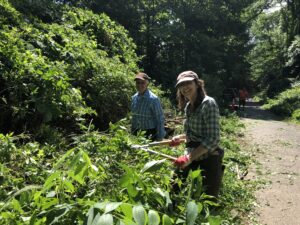 Photo by Trust Staff
Photo by Trust Staff
The C&O Canal National Historical Park (NHP) is home to over 1,500 species of plants, including over 260 non-native plant species. The C&O Canal NHP’s Natural Resources staff has made significant progress on the management and removal of invasive species found within the Park throughout 2023. Through a partnership between the Park’s Natural Resources staff and the NPS National Capital Region Invasive Plant Management (IPM) team, treatment planning and work is underway.
Throughout the winter of 2023, larger invasive species populations were recorded and identified in areas of the Park in Licking Creek, Sideling Hill Creek, and Catoctin Creek. Due to the careful mapping of populations of Japanese knotweed (Reynoutria japonica)in these areas of the Park, Park staff were able to follow through with a treatment plan that includes “cut stumping” during the summer months. Japanese knotweed is notorious for disrupting sensitive turtle nesting habitats as well as areas of the Park that house various rare plant species, such as S1 critically imperiled Hasteola suaveolens, S1S2 critically imperiled Scutellaria nervosa, S1 critically imperiled Valeriana pauciflora, and S1 critically imperiled Scutellaria saxatilis.
 Photo by Francis Grant0-Suttie
Photo by Francis Grant0-Suttie
 Photo by Francis Grant-Suttie
Photo by Francis Grant-Suttie
Further research and mapping was conducted on invasive species, Wavyleaf basketgrass (Oplismenus undulatifolius) at Hancock, Weverton, Edwards Ferry, and Pennyfield. In late winter and spring, the IPM team prioritized removal of species threatening rare, threatened, and endangered plants in the Park. Moxley mechanically removed Japanese hops (Humulus japonicus) that was strangling S1 critically imperiled Hasteola suaveolens at Catoctin Creek, followed by Japanese stiltgrass (Microstegium vimenium) that was smothering S1S2 critically imperiled Scutellaria nervosa at Chilton Woods, S1 critically imperiled Valeriana pauciflora at Carderock, and S1 critically imperiled Scutellaria saxatilis on Bear Island.
Later in the season, the IPM team conducted cut stump treatment of Chinese bush clover (Lespedeza cuneata) threatening S1 critically imperiled Paronychia virginica at Billy Goat Trail A, as well as cut stump treatment of English ivy (Hedera helix) threatening cultural resources at Burnside House.
Control efforts began throughout the spring on large infestations of bamboo (Phyllostachys aurea) at Brunswick, and continued and English ivy/ wintercreeper (Euonymus fortunei) control efforts at Seneca Creek, Brunswick, and Antietam Creek.
Throughout the spring and summer, the C&O Canal Trust partners with the National Park Service to target various sections of the Park to remove invasive plant species. This year alone, the Trust led four invasive species removal projects during Canal Community Days; in total, C&O Canal Trust volunteers removed 2,125 pounds of vegetation – namely garlic mustard from areas of the Park. A larger effort to remove invasives was scheduled for September during National Public Lands Day at Rileys Lock but was unfortunately rescheduled due to inclement weather. Stay tuned for the reschedule date! We look forward to continuing this important work with the Park on invasive plant management.
For more information about non-native plants in the C&O Canal NHP, please visit this Park page here.





